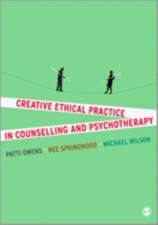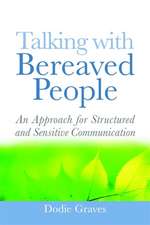Improving the Effectiveness of the Helping Professions: An Evidence-Based Approach to Practice
Autor Morley D. Glickenen Limba Engleză Hardback – 18 oct 2004
Preț: 841.91 lei
Preț vechi: 1153.31 lei
-27% Nou
Puncte Express: 1263
Preț estimativ în valută:
161.10€ • 168.63$ • 134.09£
161.10€ • 168.63$ • 134.09£
Carte tipărită la comandă
Livrare economică 31 martie-14 aprilie
Preluare comenzi: 021 569.72.76
Specificații
ISBN-13: 9780761930259
ISBN-10: 0761930256
Pagini: 352
Dimensiuni: 178 x 254 x 25 mm
Greutate: 0.8 kg
Ediția:New.
Editura: SAGE Publications
Colecția Sage Publications, Inc
Locul publicării:Thousand Oaks, United States
ISBN-10: 0761930256
Pagini: 352
Dimensiuni: 178 x 254 x 25 mm
Greutate: 0.8 kg
Ediția:New.
Editura: SAGE Publications
Colecția Sage Publications, Inc
Locul publicării:Thousand Oaks, United States
Cuprins
Acknowledgments & Preface
Part 1: THE CORE BELIEFS OF EVIDENCE-BASED PRACTICE
Chapter 1: An Explanation of Evidence-Based Practice
Definitions of EBP
Concerns About EBP From the Practice Community
Additional Criticisms of EBP With Responses
Is Evidence-Based Practice Applicable to the Helping Professions?
Summary
Integrative Questions
References
Chapter 2: A Simple Guide to Reading and Understanding Practice Research
Understanding the Scientific Method
A Few Important Issues to Consider When Reading Research
The Types of Research Studies
Quantitative (Empirical) Designs
Controlling for False Findings: Internal and External Validity
Internal Validity: Threats to Finding Cause-Effect Relationships
External Validity: Problems in Research That Limit Our Ability to Generalize Our Findings to Other Similar People, Situations, or Events
Sampling: A General Discussion
Sampling a Population Whose Members Are Known: Probability Sampling
Sampling a Population Whose Members Are Not Known: Nonprobability Sampling
Incorrect Conclusions
Reviews of Research That Yield Best Evidence
Applying Best Evidence to Practice
Summary
Integrative Questions
References
Chapter 3: The Importance of Critical Thinking in Evidence-Based Practice
Ways of Knowing
Mythologized Knowledge
Understanding the Logical Progressions in Research Ideas
Summary
Integrative Questions
References
Chapter 4: Locating Relevant Clinical Research
Useful and Not-So-Useful Sources
Evaluating the Quality of Articles Reviewed
Locating Relevant Research
Locating Evidence-Based Material on the Internet
Common Internet Sources
Summary
Integrative Questions
References
Part 2: HOW EBP VIEWS DIAGNOSIS, ASSESSMENT, AND WORKER- CLIENT RELATIONSHIPS
Chapter 5: Using Evidence-Based Practice in Diagnosis
Concerns About the Diagnostic Process
Reducing Errors in Diagnosis
The Adverse Impact of Labeling
Case Study: A Culturally Sensitive Diagnosis
Examples of EBP Diagnostic Data
Case Study: A Misdiagnosis
Highly Aggressive and Violent Young Children
Summary
Integrative Questions
References
Chapter 6: Evidence-Based Practice and Psychosocial Assessments
Case Study: Evidence-Based Practice and the Assessment Process
The Psychosocial Assessment Outline and the Relevant Information Pertaining to the Case
Summary
Integrative Questions
References
Chapter 7: Evidence-Based Practice and the Client-Worker Relationship: The Significance of the Therapeutic Relationship
Defining the Therapeutic Relationship
Evidence of the Importance of the Therapeutic Relationship to Treatment Outcomes
Gender and the Therapeutic Relationships
Racial and Ethnic Variables in Therapeutic Effectiveness
Case Study: A Positive Therapeutic Relationship
Summary
Integrative Questions
References
Part 3: EVIDENCE-BASED PRACTICE WITH SPECIAL CLIENT POPULATIONS
Chapter 8: Evidence-Based Practice Wth Cluster B Personality Disorders
The Four Types of Cluster B Personality Disorders
Developmental Theories Explaining Cluster B Personality Disorders
Treating Cluster B Personality Disorders: An Evidence-Based Practice Perspective
Case Study: EBP With a Borderline Personality-Disordered Client
Summary
Integrative Questions
References
Chapter 9: Evidence-Based Practice With Victims of Violence and Terrorism
Understanding the Link Between Trauma and the Development of Posttraumatic Stress Disorder
The Potential for Developing PTSD
The Prevalence of PTSD
The Impact of Recent Acts of Terrorism
Case Study: Adapting to a Terrorist Attack
Best Evidence of Effective Treatment for PTSD
The Recovery Process
Summary
Integrative Questions
References
Chapter 10: Evidence-Based Practice With Substance Abusers
Diagnostic Markers of Substance Abuse
Best Evidence for the Treatment of Substance Abuse
Case Study: A Brief Intervention After an Alcohol-Related Car Accident
Research Problems and Best Evidence
Summary
Integrative Questions
References
Chapter 11: Evidence-Based Practice With Mental Illness and Mood Disorders
The Extent and Impact of Mental Illness
Definitions of Mental Illness and Mood Disorders
Treatment Effectiveness Research
Case Study: Spontaneous Remission From Mental Illness
Summary
Integrative Questions
References
Chapter 12: Evidence-Based Practice With Terminal Illness and Bereavement
Terminal Illness
A Case Study: EBP With Terminal Illness
Bereavement
Case Study: EBP With Prolonged Grief
Summary
Integrative Questions
References
Chapter 13: Evidence-Based Practice With Anxiety and Depression in Older Adults
Anxiety in Older Adults
Best Evidence for the Treatment of Anxiety With an Older Adult Population
Case Study: Anxiety in an Older Client
Depression in Older Adults
Best Evidence for Treating Depression in Older Clients
Case Study: Depression in an Older Adult
Single-Subject Approaches to Evaluate Depression in Older Adults
A Goal Attainment Scale Measuring Improvement in Depression
How to Calculate the Overall Gain Made on a Goal Attainment Scale
Summary
Integrative Questions
References
Part 4: EVIDENCE-BASED PRACTICE AND ALTERNATIVE APPROACHES TO HELPING
Chapter 14: Evidence-Based Practice and the Significance of Religion and Spirituality
Definitions of Spirituality and Religious Involvement
The Impact of Spirituality and Religious Involvement on Physical and Mental Health
Case Study: A Client Using Religion to Cope With a Traumatic Childhood
Why Does Religious and Spiritual Involvement Impact Physical and Mental Health?
Should Issues of Religion and Spirituality Be Included in the Work of the Helping Professions?
Case Study: Religious Issues Discussed in Treatment
Problematic Research Issues
Summary
Integrative Questions
References
Chapter 15: Evidence-Based Practice and the Effectiveness of Indigenous Helpers and Self-Help Groups
Self-Help Groups
The Indigenous Leaders of Self-Help Groups
Case Study: An Indigenous Helper Starts a Self-Help Group
Best Evidence of the Effectiveness of Self-Help Groups
Q and A With the Author About the Meaning of These Studies
Case Study: Referral of a Client to a Self-Help Group for Severe Depression
Summary
Integrative Questions
References
Part 5: EVIDENCE-BASED PRACTICE AND FUTURE TRENDS, SOCIAL INVOLVEMENT, AND FINAL WORDS
Chapter 16: The Future of Psychotherapy
The Need for Practice Research
Alternative Ideas for Research on Treatment Efficacy
The Future of the Helping Professions
A Case Study: An Incompetent Worker Treats Chronic Depression
A Different Kind of Future: Workers Share Their Thoughts
Summary
Integrative Questions
References
Chapter 17: Some Final Words
Social Involvement
Avoiding Serious Practice Issues
Final Words
Summary
Integrative Questions
References
About the Author
Index
Part 1: THE CORE BELIEFS OF EVIDENCE-BASED PRACTICE
Chapter 1: An Explanation of Evidence-Based Practice
Definitions of EBP
Concerns About EBP From the Practice Community
Additional Criticisms of EBP With Responses
Is Evidence-Based Practice Applicable to the Helping Professions?
Summary
Integrative Questions
References
Chapter 2: A Simple Guide to Reading and Understanding Practice Research
Understanding the Scientific Method
A Few Important Issues to Consider When Reading Research
The Types of Research Studies
Quantitative (Empirical) Designs
Controlling for False Findings: Internal and External Validity
Internal Validity: Threats to Finding Cause-Effect Relationships
External Validity: Problems in Research That Limit Our Ability to Generalize Our Findings to Other Similar People, Situations, or Events
Sampling: A General Discussion
Sampling a Population Whose Members Are Known: Probability Sampling
Sampling a Population Whose Members Are Not Known: Nonprobability Sampling
Incorrect Conclusions
Reviews of Research That Yield Best Evidence
Applying Best Evidence to Practice
Summary
Integrative Questions
References
Chapter 3: The Importance of Critical Thinking in Evidence-Based Practice
Ways of Knowing
Mythologized Knowledge
Understanding the Logical Progressions in Research Ideas
Summary
Integrative Questions
References
Chapter 4: Locating Relevant Clinical Research
Useful and Not-So-Useful Sources
Evaluating the Quality of Articles Reviewed
Locating Relevant Research
Locating Evidence-Based Material on the Internet
Common Internet Sources
Summary
Integrative Questions
References
Part 2: HOW EBP VIEWS DIAGNOSIS, ASSESSMENT, AND WORKER- CLIENT RELATIONSHIPS
Chapter 5: Using Evidence-Based Practice in Diagnosis
Concerns About the Diagnostic Process
Reducing Errors in Diagnosis
The Adverse Impact of Labeling
Case Study: A Culturally Sensitive Diagnosis
Examples of EBP Diagnostic Data
Case Study: A Misdiagnosis
Highly Aggressive and Violent Young Children
Summary
Integrative Questions
References
Chapter 6: Evidence-Based Practice and Psychosocial Assessments
Case Study: Evidence-Based Practice and the Assessment Process
The Psychosocial Assessment Outline and the Relevant Information Pertaining to the Case
Summary
Integrative Questions
References
Chapter 7: Evidence-Based Practice and the Client-Worker Relationship: The Significance of the Therapeutic Relationship
Defining the Therapeutic Relationship
Evidence of the Importance of the Therapeutic Relationship to Treatment Outcomes
Gender and the Therapeutic Relationships
Racial and Ethnic Variables in Therapeutic Effectiveness
Case Study: A Positive Therapeutic Relationship
Summary
Integrative Questions
References
Part 3: EVIDENCE-BASED PRACTICE WITH SPECIAL CLIENT POPULATIONS
Chapter 8: Evidence-Based Practice Wth Cluster B Personality Disorders
The Four Types of Cluster B Personality Disorders
Developmental Theories Explaining Cluster B Personality Disorders
Treating Cluster B Personality Disorders: An Evidence-Based Practice Perspective
Case Study: EBP With a Borderline Personality-Disordered Client
Summary
Integrative Questions
References
Chapter 9: Evidence-Based Practice With Victims of Violence and Terrorism
Understanding the Link Between Trauma and the Development of Posttraumatic Stress Disorder
The Potential for Developing PTSD
The Prevalence of PTSD
The Impact of Recent Acts of Terrorism
Case Study: Adapting to a Terrorist Attack
Best Evidence of Effective Treatment for PTSD
The Recovery Process
Summary
Integrative Questions
References
Chapter 10: Evidence-Based Practice With Substance Abusers
Diagnostic Markers of Substance Abuse
Best Evidence for the Treatment of Substance Abuse
Case Study: A Brief Intervention After an Alcohol-Related Car Accident
Research Problems and Best Evidence
Summary
Integrative Questions
References
Chapter 11: Evidence-Based Practice With Mental Illness and Mood Disorders
The Extent and Impact of Mental Illness
Definitions of Mental Illness and Mood Disorders
Treatment Effectiveness Research
Case Study: Spontaneous Remission From Mental Illness
Summary
Integrative Questions
References
Chapter 12: Evidence-Based Practice With Terminal Illness and Bereavement
Terminal Illness
A Case Study: EBP With Terminal Illness
Bereavement
Case Study: EBP With Prolonged Grief
Summary
Integrative Questions
References
Chapter 13: Evidence-Based Practice With Anxiety and Depression in Older Adults
Anxiety in Older Adults
Best Evidence for the Treatment of Anxiety With an Older Adult Population
Case Study: Anxiety in an Older Client
Depression in Older Adults
Best Evidence for Treating Depression in Older Clients
Case Study: Depression in an Older Adult
Single-Subject Approaches to Evaluate Depression in Older Adults
A Goal Attainment Scale Measuring Improvement in Depression
How to Calculate the Overall Gain Made on a Goal Attainment Scale
Summary
Integrative Questions
References
Part 4: EVIDENCE-BASED PRACTICE AND ALTERNATIVE APPROACHES TO HELPING
Chapter 14: Evidence-Based Practice and the Significance of Religion and Spirituality
Definitions of Spirituality and Religious Involvement
The Impact of Spirituality and Religious Involvement on Physical and Mental Health
Case Study: A Client Using Religion to Cope With a Traumatic Childhood
Why Does Religious and Spiritual Involvement Impact Physical and Mental Health?
Should Issues of Religion and Spirituality Be Included in the Work of the Helping Professions?
Case Study: Religious Issues Discussed in Treatment
Problematic Research Issues
Summary
Integrative Questions
References
Chapter 15: Evidence-Based Practice and the Effectiveness of Indigenous Helpers and Self-Help Groups
Self-Help Groups
The Indigenous Leaders of Self-Help Groups
Case Study: An Indigenous Helper Starts a Self-Help Group
Best Evidence of the Effectiveness of Self-Help Groups
Q and A With the Author About the Meaning of These Studies
Case Study: Referral of a Client to a Self-Help Group for Severe Depression
Summary
Integrative Questions
References
Part 5: EVIDENCE-BASED PRACTICE AND FUTURE TRENDS, SOCIAL INVOLVEMENT, AND FINAL WORDS
Chapter 16: The Future of Psychotherapy
The Need for Practice Research
Alternative Ideas for Research on Treatment Efficacy
The Future of the Helping Professions
A Case Study: An Incompetent Worker Treats Chronic Depression
A Different Kind of Future: Workers Share Their Thoughts
Summary
Integrative Questions
References
Chapter 17: Some Final Words
Social Involvement
Avoiding Serious Practice Issues
Final Words
Summary
Integrative Questions
References
About the Author
Index
Notă biografică
Descriere
226333











